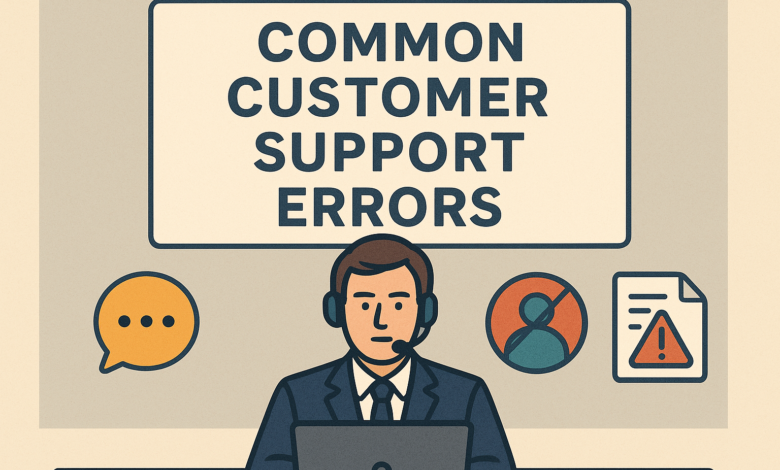Common Customer Support Errors Businesses Must Stop Making

Good customer service goes beyond just answering questions. Whatever happens in the middle will leave a lasting impression on the customer calling for help. Whether it’s an online store, bank app, or online sports betting platform, it is through customer support that customers are stimulated to decide whether to stay or go. Then, if the system errs frequently, even loyal users quietly drift away. Let’s discuss the most common pathogens affecting support services and how to address them one step at a time.
Not Responding in Time
Nobody wants to be kept waiting, especially when they’re in trouble. One of the significant mistakes businesses make is in providing a late response. Even if your answer is correct, a late reply already says you don’t care.
Everybody just wants to be acknowledged and heard quickly. Should a problem be reported and no feedback is received within hours or sometimes days, trust begins to erode. This is particularly true in time-at-matter industries, such as ticket sales, digital payments, or flight bookings. A simple message, such as “We’ve received your message. We’re on it,” means a lot. Go ahead and make full use of auto-responses, but please don’t allow these to replace the real answers.
Giving Robotic or Copy-Paste Replies
People often prefer not to converse with a voice bot when they’re upset. Unfortunately, this is what countless support teams lean on too heavily: timed, canned responses. It’s okay to rely on templates, but the catch is to humanize them. Any response that sounds cold or fails to address what the customer clearly states will make it seem as if their voice is not being heard.
Each person should receive a response that speaks to them on a personal level, even when multiple individuals are complaining about the same existing issue. Include their name. At the very least, refer to the specific problem. Be warm. Be human. If your support messages sound like they were written for everyone, they will feel as if they were written for no one.
Not Training the Support Team Properly
Support agents are on the front line. They speak directly with your users, so they must know how everything works. If they repeatedly say, “Let me check with my team,” or provide the wrong answer, customers quickly lose confidence.
Proper training doesn’t just mean teaching how the product works. It means helping agents understand tone, empathy, and patience. It means updating them anytime your service changes. A trained team fixes issues faster, speaks better, and creates better experiences. Poor training shows instantly. Customers can feel it.
Blaming the Customer
Here is the dangerous one. Some support teams attempt to protect the company by making the customer appear to have made a mistake. They say, “You should have read the terms,” or “That’s not how it works.” Although the responses may technically be correct, they leave the customers feeling belittled, angry, and unfairly treated.
Yet, even when the customer makes a mistake, your job is to make them happy, not point fingers. Change that tone: say “Here is what we can do next,” or “Let me help you with that.” It is about fixing the issue, not about who is right.
Not Following Up
Fixing the issue is excellent, but stopping there is not enough. If you never follow up, the customer may still be unsure. Did it get solved? Are there steps they still need to take? Many times, support teams close a ticket and move on. But that’s like fixing a leak without checking if the pipe still drips the next day.
A simple follow-up email or message shows that you care beyond the problem. Ask, “Is everything working fine now?” or “Is there anything else I can do?” That one message could make all the difference.
Using Hard-to-Reach Channels
Some businesses would rather hide their contact options. They put the help button inside a menu, or, worse, require customers to fill out lengthy forms just to ask a question. More than a few clicks to reach your people, and you have already annoyed your customers before that conversation even began!
Make support easy to find. Clear buttons. Short forms. Fast responses. Suppose people can chat or call directly; that would be even better. When they need help, they don’t want to go on a treasure hunt. They just want a solution.
Ignoring Feedback
Every support interaction is a chance to learn. When people complain, suggest improvements, or leave ratings, they’re providing you with valuable insights. But many teams ignore this. They solve the issue and move on, never asking what could have been done better.
That’s a lost opportunity. If five people mention the same confusion, maybe your product or instructions need work. If someone praises an agent, perhaps they should consider training others. Feedback is gold. Use it, don’t toss it aside.
Overpromising and Underdelivering
Support persons, at times, will say what the customer wants to hear to keep them happy. However, if they fail to do what is promised, it causes much more damage. Saying, “We will fix it today,” when it takes two days, is far worse than telling the truth from the beginning.
Set a clear, realistic timeline and meet it. If it is within 24 hours, then say 24 hours. If you aren’t sure yet, politely say so-people value honesty over illusory promises. Trust is built when what you say is in tandem with what you do.
Being Too Formal or Too Casual
Support messages should be lucid and polite. However, some teams take it too far with stuffy, formal language that feels cold. Others go too casual and end up sounding downright careless. The key is balance-Clear, nicer, and respectful.
Use words that your Grandma and teenage cousin can understand. Avoid lengthy business terms or complex language.
